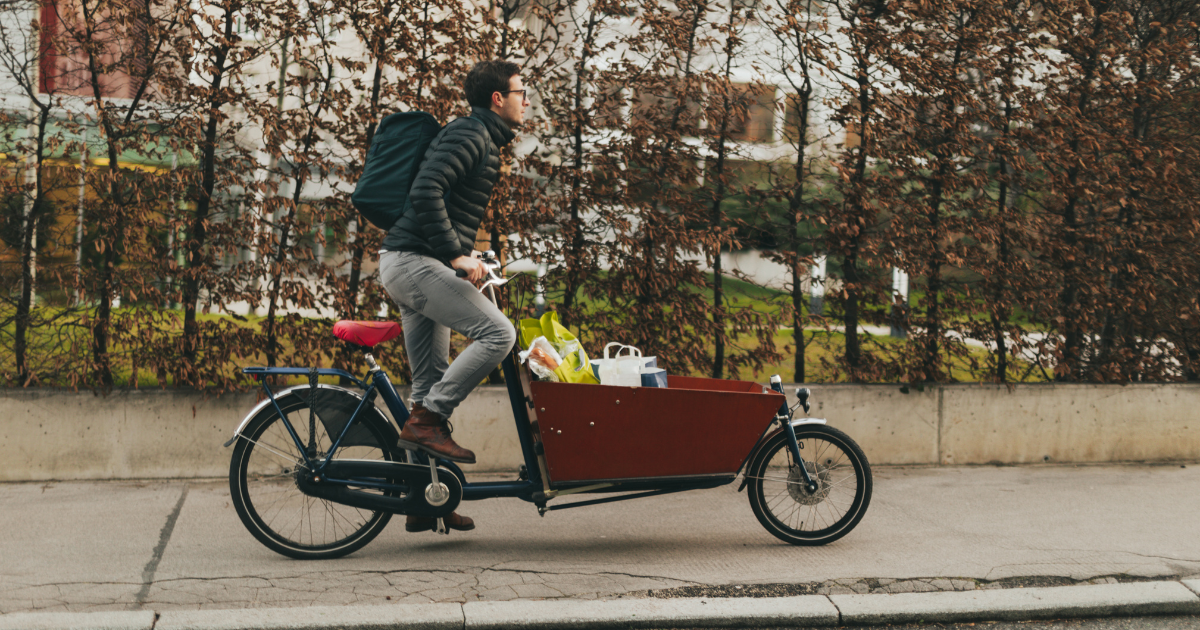
Cargo bikes or cargo bicycles are becoming increasingly more popular as a sustainable and efficient mode of transportation. The finance bill in 2022 announced a new exemption limit for the Bike to Work scheme to include an upper limit of €3,000 for the purchase of a cargo bike or e-cargo bike and necessary safety equipment. Designed to carry heavy loads, these popular bikes are ideal for transporting groceries, children, and even cargo for businesses.
One of the main reasons for the increased popularity of cargo bikes is their environmental benefits. They emit no emissions and require no fuel, making them a cleaner alternative to cars and trucks. They also reduce traffic congestion and promote active transport, which can improve public health. Another reason for their growing popularity is their versatility. Cargo bikes come in a range of styles and sizes, from traditional Dutch-style bikes to electric cargo bikes. This allows for a wide range of uses, from running errands to hauling cargo for businesses. In terms of cost-effectiveness cargo bikes require less maintenance than a car or van and have lower upfront and running costs. This makes them a great option for individuals and businesses looking for a more affordable way to transport goods.
The load capacity of cargo bikes varies depending on the model and design of the bike. Some cargo bikes can carry up to 150kg or more, while others have a more modest load capacity of around 40 – 90 kg’s.
See our load capacity illustration as a guide:

The load capacity of a cargo bike is determined by several factors, including the frame construction, the materials used, and the number and strength of the wheels. Additionally, the load capacity of electric cargo bikes is also influenced by the power of the electric motor and the capacity of the battery.
The most common type of cargo bike is the long tail bike, which has an extended rear frame to accommodate cargo or kids. These bikes have a load capacity of approx. 90kg, depending on the model. If you are looking for more capacity, a front-loading bike or a rear-loading bike with three wheels can carry up to 125kg – 150kgs with a cargo box mounted on the front or back of the bike.
Another important aspect of cargo bikes is the way the load is distributed. A well-designed cargo bike will distribute the weight evenly, making it easy to handle and manoeuvre. A poorly designed bike may have a high load capacity but may be difficult to control, especially when loaded with heavy cargo. It is important to choose a cargo bike that is well-suited to your needs and that has a suitable load capacity. Always check the weight capacity before buying and consider the weight of the cargo you will be transporting on a regular basis.
Cargo bikes are a comfortable and safe option for transporting children. Many cargo bikes come equipped with child seats and rain covers, which can be mounted on the rear or front of the bike. The seats have a weight capacity of around 18 – 22kgs and are designed to keep children secure and protected while riding.
 For more information on the SONA Shuttle electric cargo bike go to https://sonabikes.com/collections/cargo-bikes
For more information on the SONA Shuttle electric cargo bike go to https://sonabikes.com/collections/cargo-bikes
When it comes to comfort, cargo bikes have the advantage of being able to carry more than just one child. Some cargo bikes can carry up to three children, making them a great option for larger families. Often equipped with suspension systems and padded seats to provide a smooth and comfortable ride for both the rider and the passengers.
Trikes or 3-wheel cargo bikes, are a variation of cargo bikes that have three wheels instead of two. These bikes offer several advantages over traditional cargo bikes, such as increased stability and ease of use. One of the main benefits of 3-wheel cargo bikes is their stability. The third wheel provides an additional point of contact with the ground, making them less likely to tip over. This can be especially beneficial for carrying heavy loads or for riders who are not as confident on two wheels.
3-wheel cargo bikes are also often easier to ride than traditional cargo bikes. They have a lower centre of gravity and a more upright riding position, which can make them more comfortable and less tiring to ride. Additionally, they are often equipped with electric motors, which can make them even more user-friendly.
However, it's worth noting that 3-wheel cargo bikes tend to be larger and heavier than traditional cargo bikes and that may make them less manoeuvrable in tight spaces.
Storage and parking of cargo bikes can be a concern for some people, as these bikes are often larger and bulkier than traditional bicycles. However, with a little bit of planning, it is possible to find a suitable storage and parking solution for a cargo bike.
For those who don't have indoor or outdoor storage options, there are also cargo bike parking facilities. Many cities have bike parking facilities, such as bike racks or bike lockers, that can be used to store cargo bikes. Additionally, many businesses and organisations are also starting to provide cargo bike parking to support sustainable transportation.
When parking cargo bike, consider the weight of the bike, as many bike racks and bike locks are not designed for cargo bikes, and it can be difficult to secure them properly. Additionally, it is important to ensure that the bike is parked in a visible and well-lit area to reduce the risk of theft.
Overall, the increased popularity of cargo bikes can be attributed to their environmental benefits, versatility, and cost-effectiveness. As more people become aware of these benefits, it is likely that we will see even more cargo bikes on the roads in the future.


